technical data Seat Exeo ST 2012 Owner's manual
[x] Cancel search | Manufacturer: SEAT, Model Year: 2012, Model line: Exeo ST, Model: Seat Exeo ST 2012Pages: 325, PDF Size: 5.56 MB
Page 67 of 325
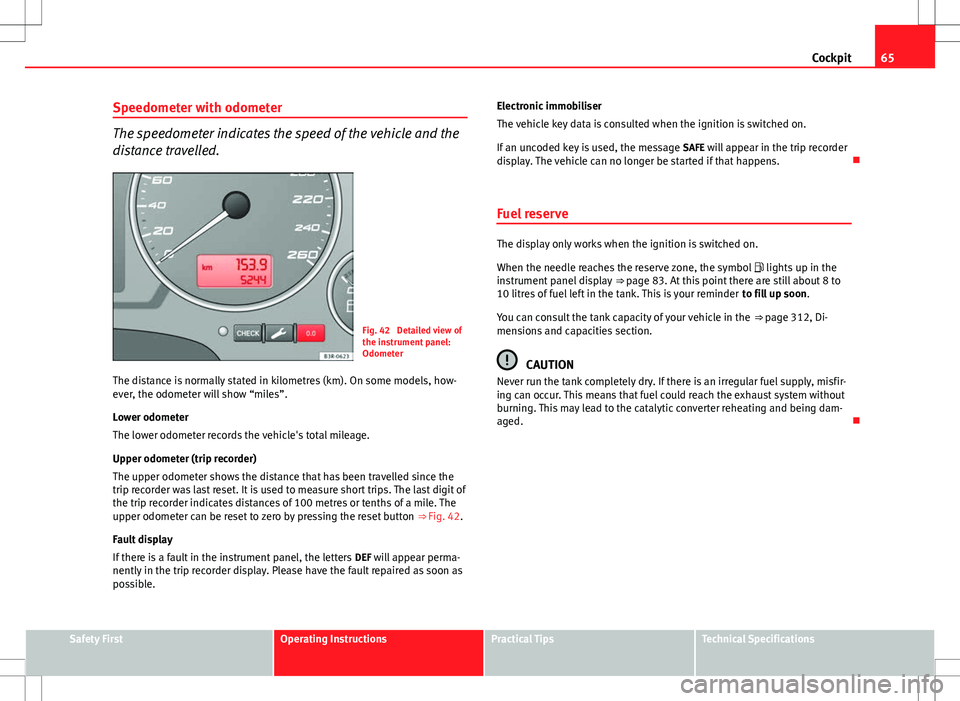
65
Cockpit
Speedometer with odometer
The speedometer indicates the speed of the vehicle and the
distance travelled.
Fig. 42 Detailed view of
the instrument panel:
Odometer
The distance is normally stated in kilometres (km). On some models, how-
ever, the odometer will show “miles”.
Lower odometer
The lower odometer records the vehicle's total mileage.
Upper odometer (trip recorder)
The upper odometer shows the distance that has been travelled since the
trip recorder was last reset. It is used to measure short trips. The last digit of
the trip recorder indicates distances of 100 metres or tenths of a mile. The
upper odometer can be reset to zero by pressing the reset button ⇒ Fig. 42.
Fault display
If there is a fault in the instrument panel, the letters DEF will appear perma-
nently in the trip recorder display. Please have the fault repaired as soon as
possible. Electronic immobiliser
The vehicle key data is consulted when the ignition is switched on.
If an uncoded key is used, the message
SAFE will appear in the trip recorder
display. The vehicle can no longer be started if that happens.
Fuel reserve
The display only works when the ignition is switched on.
When the needle reaches the reserve zone, the symbol lights up in the
instrument panel display ⇒ page 83. At this point there are still about 8 to
10 litres of fuel left in the tank. This is your reminder to fill up soon.
You can consult the tank capacity of your vehicle in the ⇒ page 312, Di-
mensions and capacities section.
CAUTION
Never run the tank completely dry. If there is an irregular fuel supply, misfir-
ing can occur. This means that fuel could reach the exhaust system without
burning. This may lead to the catalytic converter reheating and being dam-
aged.
Safety FirstOperating InstructionsPractical TipsTechnical Specifications
Page 197 of 325
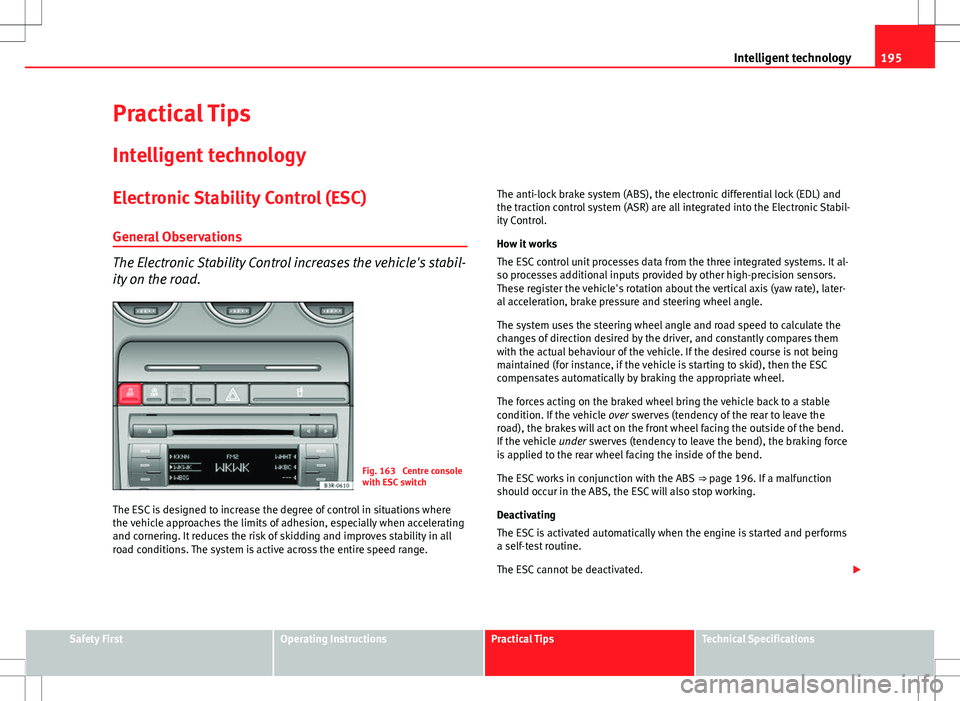
195
Intelligent technology
Practical Tips Intelligent technology
Electronic Stability Control (ESC)
General Observations
The Electronic Stability Control increases the vehicle's stabil-
ity on the road.
Fig. 163 Centre console
with ESC switch
The ESC is designed to increase the degree of control in situations where
the vehicle approaches the limits of adhesion, especially when accelerating
and cornering. It reduces the risk of skidding and improves stability in all
road conditions. The system is active across the entire speed range. The anti-lock brake system (ABS), the electronic differential lock (EDL) and
the traction control system (ASR) are all integrated into the Electronic Stabil-
ity Control.
How it works
The ESC control unit processes data from the three integrated systems. It al-
so processes additional inputs provided by other high-precision sensors.
These register the vehicle's rotation about the vertical axis (yaw rate), later-
al acceleration, brake pressure and steering wheel angle.
The system uses the steering wheel angle and road speed to calculate the
changes of direction desired by the driver, and constantly compares them
with the actual behaviour of the vehicle. If the desired course is not being
maintained (for instance, if the vehicle is starting to skid), then the ESC
compensates automatically by braking the appropriate wheel.
The forces acting on the braked wheel bring the vehicle back to a stable
condition. If the vehicle
over swerves (tendency of the rear to leave the
road), the brakes will act on the front wheel facing the outside of the bend.
If the vehicle under swerves (tendency to leave the bend), the braking force
is applied to the rear wheel facing the inside of the bend.
The ESC works in conjunction with the ABS ⇒ page 196. If a malfunction
should occur in the ABS, the ESC will also stop working.
Deactivating
The ESC is activated automatically when the engine is started and performs
a self-test routine.
The ESC cannot be deactivated.
Safety FirstOperating InstructionsPractical TipsTechnical Specifications
Page 233 of 325
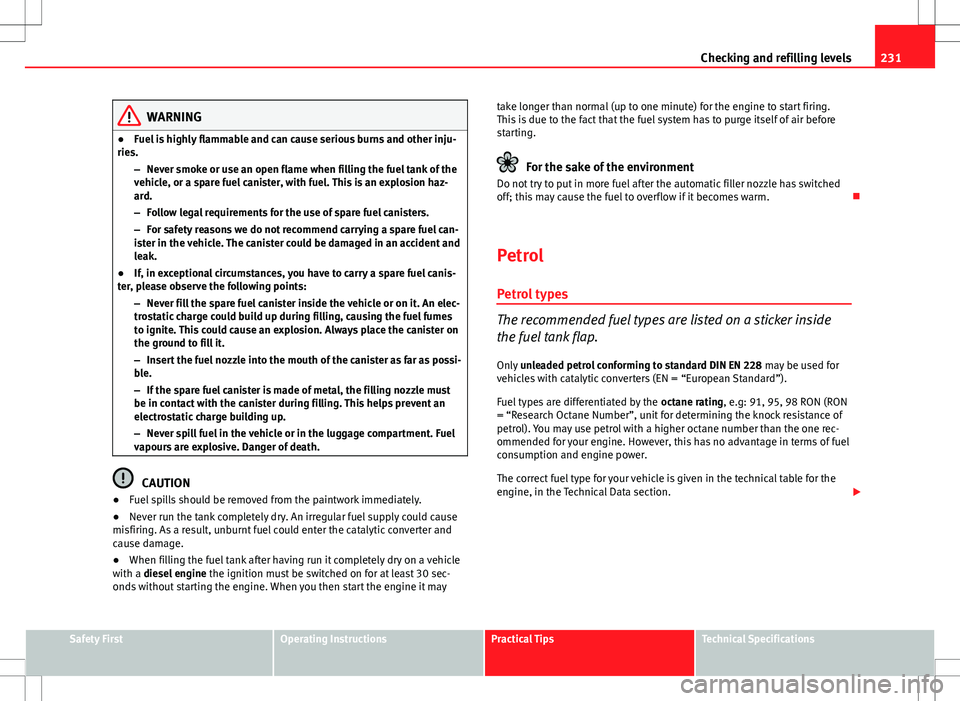
231
Checking and refilling levels
WARNING
● Fuel is highly flammable and can cause serious burns and other inju-
ries.
–Never smoke or use an open flame when filling the fuel tank of the
vehicle, or a spare fuel canister, with fuel. This is an explosion haz-
ard.
– Follow legal requirements for the use of spare fuel canisters.
– For safety reasons we do not recommend carrying a spare fuel can-
ister in the vehicle. The canister could be damaged in an accident and
leak.
● If, in exceptional circumstances, you have to carry a spare fuel canis-
ter, please observe the following points:
–Never fill the spare fuel canister inside the vehicle or on it. An elec-
trostatic charge could build up during filling, causing the fuel fumes
to ignite. This could cause an explosion. Always place the canister on
the ground to fill it.
– Insert the fuel nozzle into the mouth of the canister as far as possi-
ble.
– If the spare fuel canister is made of metal, the filling nozzle must
be in contact with the canister during filling. This helps prevent an
electrostatic charge building up.
– Never spill fuel in the vehicle or in the luggage compartment. Fuel
vapours are explosive. Danger of death.
CAUTION
● Fuel spills should be removed from the paintwork immediately.
● Never run the tank completely dry. An irregular fuel supply could cause
misfiring. As a result, unburnt fuel could enter the catalytic converter and
cause damage.
● When filling the fuel tank after having run it completely dry on a vehicle
with a diesel engine the ignition must be switched on for at least 30 sec-
onds without starting the engine. When you then start the engine it may take longer than normal (up to one minute) for the engine to start firing.
This is due to the fact that the fuel system has to purge itself of air before
starting.
For the sake of the environment
Do not try to put in more fuel after the automatic filler nozzle has switched
off; this may cause the fuel to overflow if it becomes warm.
Petrol Petrol types
The recommended fuel types are listed on a sticker inside
the fuel tank flap.
Only unleaded petrol conforming to standard DIN EN 228 may be used for
vehicles with catalytic converters (EN = “European Standard”).
Fuel types are differentiated by the octane rating, e.g: 91, 95, 98 RON (RON
= “Research Octane Number”, unit for determining the knock resistance of
petrol). You may use petrol with a higher octane number than the one rec-
ommended for your engine. However, this has no advantage in terms of fuel
consumption and engine power.
The correct fuel type for your vehicle is given in the technical table for the
engine, in the Technical Data section.
Safety FirstOperating InstructionsPractical TipsTechnical Specifications
Page 302 of 325

300Description of specifications
Technical Specifications
Description of specifications
Important information
Important
The information in your vehicle's official documents always
take precedence over the information in the current instruc-
tion manual. All technical specifications provided in this manual are valid for the stand-
ard model in Spain. The vehicle data card included in the Maintenance Pro-
gramme or the vehicle registration documents shows which engine is instal-
led in the vehicle.
The figures may be different depending on if additional equipment is fitted,
for different models, for special vehicles and for other countries.
Abbreviations used in the Technical Specifications section
Abbrevia- tionMeaning
kWKilowatt, engine power measurement.
PSPferdestärke (horsepower), formerly used to denote engine
power.
rpmRevolutions per minute - engine speed.NmNewton metres, unit of engine torque.l/100 kmFuel consumption in litres per 100 km.g/kmCarbon dioxide emissions in grams per km travelled.CO2Carbon dioxide
Abbrevia-
tionMeaning
CNCetane number, indication of the diesel combustion power.
RONResearch octane number, indication of the knock resistance
of petrol.
Page 303 of 325

301
Description of specifications
Vehicle identification data
The most important information is given on the identifica-
tion plate and the vehicle data sticker.
Fig. 247 Vehicle data
sticker (luggage compart-
ment)
Vehicles for certain export countries do not have an identification plate.
Identification plate
The identification plate is located on the left rib inside the engine compart-
ment.
Vehicle identification number
The vehicle identification number (chassis number) can be read from out-
side the vehicle through a viewer in the windscreen. This is located on the
left-hand side of the vehicle in the lower area of the windscreen. It is also
located on the right hand side of the engine compartment. Vehicle data
The data sticker is placed on the inside of the spare wheel well, in the lug-
gage compartment and on the rear cover of the Maintenance Programme.
The following information is provided on the vehicle data sticker:
⇒ Fig. 247
Production control number
Vehicle identification number (chassis number)
Model code number
Model designation / engine power output
Engine and gearbox code letters
Paintwork number / interior trim code
Optional equipment codes
Consumption values
CO 2 emissions values
At the end of the data sticker, in points 8
and 9, you can see the con-
sumption and emission information.
Information on consumption and emissions
Urban consumption (l/100 km)
Urban CO 2 emissions (g/km)
Extra-urban consumption (l/100 km)
Extra-urban CO 2 emissions (g/km)
Combined consumption (l/100 km)
Combined CO 2 emissions (g/km)
1
23456789
A
B
C
Safety FirstOperating InstructionsPractical TipsTechnical Specifications
Page 314 of 325
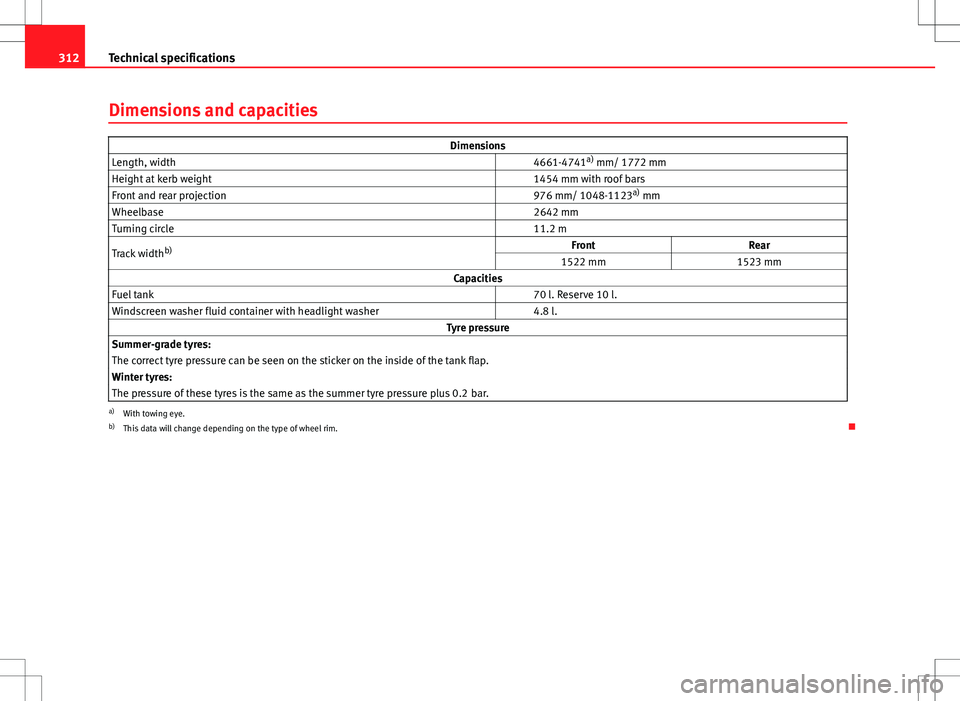
312Technical specifications
Dimensions and capacities
Dimensions
Length, width 4661-4741a)
mm/ 1772 mm
Height at kerb weight 1454 mm with roof bars
Front and rear projection 976 mm/ 1048-1123a)
mm
Wheelbase 2642 mm
Turning circle 11.2 m
Track width b) Front
Rear
1522 mm 1523 mm
Capacities
Fuel tank 70 l. Reserve 10 l.
Windscreen washer fluid container with headlight washer 4.8 l.
Tyre pressure
Summer-grade tyres:
The correct tyre pressure can be seen on the sticker on the inside of the tank flap.
Winter tyres:
The pressure of these tyres is the same as the summer tyre pressure plus 0.2 bar.
a) With towing eye.
b) This data will change depending on the type of wheel rim.
Page 322 of 325
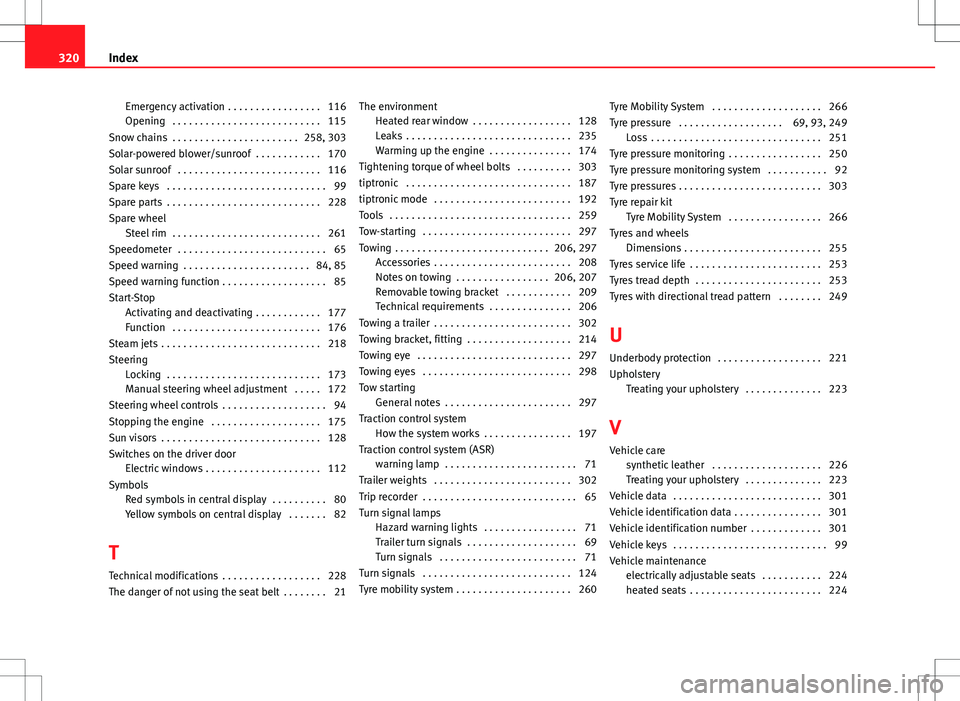
Emergency activation . . . . . . . . . . . . . . . . . 116
Opening . . . . . . . . . . . . . . . . . . . . . . . . . . . 115
Snow chains . . . . . . . . . . . . . . . . . . . . . . . 258, 303
Solar-powered blower/sunroof . . . . . . . . . . . . 170
Solar sunroof . . . . . . . . . . . . . . . . . . . . . . . . . . 116
Spare keys . . . . . . . . . . . . . . . . . . . . . . . . . . . . . 99
Spare parts . . . . . . . . . . . . . . . . . . . . . . . . . . . . 228
Spare wheel Steel rim . . . . . . . . . . . . . . . . . . . . . . . . . . . 261
Speedometer . . . . . . . . . . . . . . . . . . . . . . . . . . . 65
Speed warning . . . . . . . . . . . . . . . . . . . . . . . 84, 85
Speed warning function . . . . . . . . . . . . . . . . . . . 85
Start-Stop Activating and deactivating . . . . . . . . . . . . 177
Function . . . . . . . . . . . . . . . . . . . . . . . . . . . 176
Steam jets . . . . . . . . . . . . . . . . . . . . . . . . . . . . . 218
Steering Locking . . . . . . . . . . . . . . . . . . . . . . . . . . . . 173
Manual steering wheel adjustment . . . . . 172
Steering wheel controls . . . . . . . . . . . . . . . . . . . 94
Stopping the engine . . . . . . . . . . . . . . . . . . . . 175
Sun visors . . . . . . . . . . . . . . . . . . . . . . . . . . . . . 128
Switches on the driver door Electric windows . . . . . . . . . . . . . . . . . . . . . 112
Symbols Red symbols in central display . . . . . . . . . . 80
Yellow symbols on central display . . . . . . . 82
T Technical modifications . . . . . . . . . . . . . . . . . . 228
The danger of not using the seat belt . . . . . . . . 21 The environment
Heated rear window . . . . . . . . . . . . . . . . . . 128
Leaks . . . . . . . . . . . . . . . . . . . . . . . . . . . . . . 235
Warming up the engine . . . . . . . . . . . . . . . 174
Tightening torque of wheel bolts . . . . . . . . . . 303
tiptronic . . . . . . . . . . . . . . . . . . . . . . . . . . . . . . 187
tiptronic mode . . . . . . . . . . . . . . . . . . . . . . . . . 192
Tools . . . . . . . . . . . . . . . . . . . . . . . . . . . . . . . . . 259
Tow-starting . . . . . . . . . . . . . . . . . . . . . . . . . . . 297
Towing . . . . . . . . . . . . . . . . . . . . . . . . . . . . 206, 297 Accessories . . . . . . . . . . . . . . . . . . . . . . . . . 208
Notes on towing . . . . . . . . . . . . . . . . . 206, 207
Removable towing bracket . . . . . . . . . . . . 209
Technical requirements . . . . . . . . . . . . . . . 206
Towing a trailer . . . . . . . . . . . . . . . . . . . . . . . . . 302
Towing bracket, fitting . . . . . . . . . . . . . . . . . . . 214
Towing eye . . . . . . . . . . . . . . . . . . . . . . . . . . . . 297
Towing eyes . . . . . . . . . . . . . . . . . . . . . . . . . . . 298
Tow starting General notes . . . . . . . . . . . . . . . . . . . . . . . 297
Traction control system How the system works . . . . . . . . . . . . . . . . 197
Traction control system (ASR) warning lamp . . . . . . . . . . . . . . . . . . . . . . . . 71
Trailer weights . . . . . . . . . . . . . . . . . . . . . . . . . 302
Trip recorder . . . . . . . . . . . . . . . . . . . . . . . . . . . . 65
Turn signal lamps Hazard warning lights . . . . . . . . . . . . . . . . . 71
Trailer turn signals . . . . . . . . . . . . . . . . . . . . 69
Turn signals . . . . . . . . . . . . . . . . . . . . . . . . . 71
Turn signals . . . . . . . . . . . . . . . . . . . . . . . . . . . 124
Tyre mobility system . . . . . . . . . . . . . . . . . . . . . 260 Tyre Mobility System . . . . . . . . . . . . . . . . . . . . 266
Tyre pressure . . . . . . . . . . . . . . . . . . . 69, 93, 249
Loss . . . . . . . . . . . . . . . . . . . . . . . . . . . . . . . 251
Tyre pressure monitoring . . . . . . . . . . . . . . . . . 250
Tyre pressure monitoring system . . . . . . . . . . . 92
Tyre pressures . . . . . . . . . . . . . . . . . . . . . . . . . . 303
Tyre repair kit Tyre Mobility System . . . . . . . . . . . . . . . . . 266
Tyres and wheels Dimensions . . . . . . . . . . . . . . . . . . . . . . . . . 255
Tyres service life . . . . . . . . . . . . . . . . . . . . . . . . 253
Tyres tread depth . . . . . . . . . . . . . . . . . . . . . . . 253
Tyres with directional tread pattern . . . . . . . . 249
U Underbody protection . . . . . . . . . . . . . . . . . . . 221
Upholstery Treating your upholstery . . . . . . . . . . . . . . 223
V
Vehicle care synthetic leather . . . . . . . . . . . . . . . . . . . . 226
Treating your upholstery . . . . . . . . . . . . . . 223
Vehicle data . . . . . . . . . . . . . . . . . . . . . . . . . . . 301
Vehicle identification data . . . . . . . . . . . . . . . . 301
Vehicle identification number . . . . . . . . . . . . . 301
Vehicle keys . . . . . . . . . . . . . . . . . . . . . . . . . . . . 99
Vehicle maintenance electrically adjustable seats . . . . . . . . . . . 224
heated seats . . . . . . . . . . . . . . . . . . . . . . . . 224
320 Index